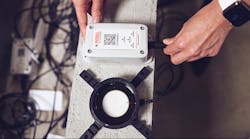Concrete is a necessary ingredient of modern highway infrastructure, but not quite so much of it may be required. A sensor developed at Purdue University and embedded directly into a concrete pour may enable concrete to “talk” about its condition and when it needs repairs. It may also improve the sustainability of roads using concrete and lead to less concrete for the road infrastructure. Because making concrete contributes so much to the world’s carbon gas footprint, the sensor could significantly reduce the carbon footprint, too.
Luna Lu, the Reilly Professor and acting head of Purdue’s Lyles School of Civil Engineering, has been leading the development of the sensor since 2017. The sensor provides more precise data about the concrete’s condition than possible with current measurement methods. Traffic jams during road repairs consume 4 billion hours and 3 billion gallons of gas per year. This sensor could help curb those numbers.
According to the U.S. Federal Highway Administration (FHA), concrete pavement forms less than 2% of U. S. roads but about 20% of the highway system, and the material is difficult to repair. Many states, including California and Texas, have agreed to implement the sensors as part of an FHA-pooled fund.
REBEL Sensors
The sensors will also be marketed as the REBEL Concrete Strength Sensing System (see image above), produced by WaveLogix, a company founded by Lu in 2021. The company licenses the technology from the Purdue Research Foundation Office of Technology Commercialization, which has applied for patent protection in intellectual property (IP).
The innovative sensor may replace testing methods that have served as the industry’s standards since the early 1900s. Those techniques involve analyzing large samples of concrete in a laboratory or on-site facility. With that data, estimates are made of the strength of a particular concrete mix after it's been poured and left to mature at a construction site. Discrepancies between laboratory and outdoor conditions can lead to inaccurate estimates of the concrete’s strength.
Lu believes that the new method, when used with artificial intelligence (AI), could reduce the amount of cement used in concrete mixes by 20% to 25%. The approach would simultaneously make pavement more durable and less expensive.
“I feel a strong sense of responsibility to make an impact on our infrastructure through developing new types of technology," said Lu. "In the field of civil engineering, if we don’t make an impact on the world, there won’t be a world to worry about.”
The sensor uses wireless technology via cellular telephone networks to communicate data from the road.
